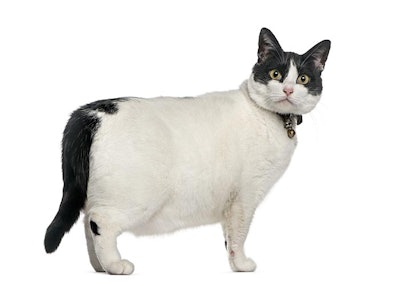
Quarantine 15. COVID 15. Whatever the term used, some people emerged from the initial pandemic lockdowns in 2020 having put on weight, due to lower activity, overeating to alleviate stress or boredom, or all of the above.
As of late 2020, U.S. pet owners were reporting they saw similar weight gains in their pets. In a survey conducted in November 2020 by Hill’s Pet Nutrition in conjunction with Kelton Global, 33% of the 1,021 pet owners surveyed who have overweight pets said the pets gained pounds during the pandemic.
At least these pet owners recognized the issue, which is not always the case: Of 257 veterinarians also surveyed by Hill’s and Kelton, only 12% said pet owners proactively mentioned concerns about their pets’ weight during vet visits. Conversely, 64% of the veterinarians surveyed said pet owners acted surprised or defensive when the veterinarian said the pet was overweight.
The ‘fat gap’ for pets continues
This “fat gap”—the difference between pet owner awareness of their pets’ weight and veterinarians’ professional assessment of pets being overweight or obese—was first identified several years ago by the Association for Pet Obesity Prevention (APOP). Unfortunately, in addition to possibly contributing to pet overweight and obesity, the pandemic has also hampered efforts to track the incidence and associated factors like the fat gap.
Founded in 2005 by Ernie Ward, D.V.M., the nonprofit APOP began conducting a pet obesity survey in 2007. This happened annually through 2019, with each year’s survey collecting and analyzing data from the previous year. The survey consisted of an online form for pet owners and veterinary professionals to complete, plus a pet obesity prevalence survey specifically for veterinary clinics.
Then came COVID-19. As with so many other initiatives and programs put on hold during 2020, APOP was unable to do its obesity survey. Thankfully, it’s back in 2021 (gathering data from 2020)—but only the online form, which is open now. With the ongoing pandemic continuing to create a nationwide backlog for veterinary appointments and procedures, as well as clinics experiencing the staffing challenges so prevalent in all fields, APOP has decided to postpone that element until 2022.
While the 2021 online form will likely reveal valuable data and insights on the current state of pet obesity in the U.S., not having the clinical prevalence survey could hamper information and analysis of the so-called fat gap. In 2016, when it appears APOP last focused on the fat gap in its survey findings, 81% of responding pet owners reported their pets as being a normal and healthy weight, meaning only 19% thought their pets were overweight or obese—compared to 53.9% of dogs and 58.9% of cats according to professional veterinary assessments.
Judging by the veterinarian responses to Hill’s 2020 survey about pet owner reaction to notice of their pets’ weight issues, my hunch is that a sizable gap still exists.
America’s fat dogs (and cats)
For a different way to track pet obesity, a veterinary enterprise called One Vet surveyed 2,430 U.S. dog owners about their dogs’ breed and weight, according to an article by Carley Lintz on PetBusiness.com. One Vet then figured an average weight for each breed reported and compared it to weights for those breeds recommended by the American Kennel Club.
Based on this data, One Vet determined that on average, American dogs are 11.83 pounds overweight! That may not seem so bad for large or giant dog breeds, but if the math and logic hold up, it doesn’t bode well for small or medium-size breeds, even if their average weights and amount of overweight were lower than those for larger breeds.
“Broken down by breed, the chubbiest types of dogs were Bulldogs, Beagles, Pugs, Chihuahuas, Pomeranians, Maltese and Yorkshire Terriers,” Lintz wrote. “All seven are small to medium-sized breeds, which means that just a few extra pounds can make a big difference. Surprisingly, Labrador Retrievers did not make the list even though they are one of the breeds most prone to obesity.”
Now, we have to consider that this data is owner reported; some may have guessed at their dogs’ weight or used a figure from a months- or years-ago vet visit, rather than weighing their dogs accurately before completing the survey. Owners may have also guessed or embellished in terms of their dogs’ breeds, selecting Beagle, for example, for a mixed-breed dog with markings or a body type resembling that breed.
That may be splitting hairs, because the point is, even this self-reported data indicate a lot of pudgy pups. A similar survey of cats would probably show a high prevalence of tubby tabbies, too.
Pet food and nutrition’s role in pet obesity
Obviously, pet food and nutrition should, and do, factor significantly in pets’ weight, but ascertaining what pet owners understand about that can be a challenge. For the last few years that APOP was able to conduct its pet obesity study, it included questions about owner (and veterinary) perceptions of specific types of pet food and ingredients; the answers may provide insights for pet food marketers.
For example, in 2016, 61% of dog owners said they believed no- or low-grain diets are healthier; that dropped to 40% in 2018, after the Food and Drug Administration launched its investigation into a possible link (since disproven) between such diets and canine dilated cardiomyopathy.
A similar question about corn as an ingredient in dog food showed only 6% of owners in 2016 thought it was healthy, and only 5% in 2017. The survey also tracked owner and veterinary perceptions of organic and raw pet food.
I encourage everyone in the industry to peruse this data from past surveys, which APOP helpfully presents in a series of infographics on the 2016 survey results page, and to watch for results of the 2021 survey, likely available in early 2022.
















